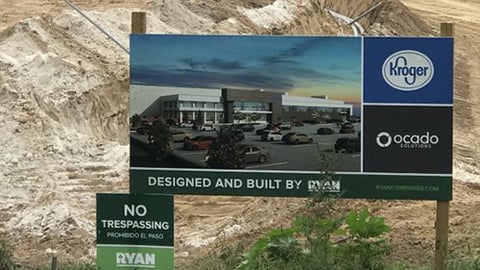Ocado Rides Pandemic Sales Surge
Ocado's robot army delivered an 27% increase in retail sales during the first half of this year, as the U.K. company revealed it has more than 1 million people on a waiting list for its online grocery service.
CEO Tim Steiner said during an earnings call that Ocado, which has about 800,000 customers, could have increased sales more than five times over given the level of demand during the pandemic but was held back by the limits of its warehouses and delivery network.
“The world as we know it has changed,” Steiner said. “As a result of Covid‐19 we have seen years of growth in the online grocery market condensed into a matter of months and we won’t be going back.” He said he expects a “permanent redrawing of the landscape of the grocery industry worldwide” that would mean more demand for its technology and expertise.
Ocado said overall retail sales were up 27% in the first half of the year. Ocado group revenue rose 23.2% to $1.30 billion. But higher costs ate into group EBITDA, which fell 36% to $24.8 million, leaving the company with a pre-tax loss of $50.9 million.
Ocado says it will be able to leverage coronavirus-related demand for grocery delivery into an increase in international retail partners such as Kroger, as grocers look to increase their online capacity.
"We are confident that accelerated growth in the online channel will continue, leading to a permanent redrawing of the landscape of the grocery industry worldwide," Stein said. "This will mean more demand for Ocado Smart Platform from current and prospective partners and our recent fundraising will ensure that we are able to meet that demand. It will also mean that we can invest more capital in innovation for our partners and further expand our leadership as the world’s preeminent solutions provider in online grocery."
COVID-19 has significantly accelerated the ongoing channel shift to online grocery. Industry data evidences that this is a global trend; in the U.K online penetration has nearly doubled within a few months. In the U.S., by late June, monthly online grocery sales had reached a level six times what they were in August last year, and in China the major online grocery platforms saw triple digit year-on-year sales growth during the COVID-19 outbreak.
"We believe that this channel shift is sustainable, as survey data shows that many consumers who were shopping online during the peak of the pandemic in their respective countries have either continued to do so (56% of those in China), or intend to continue online shopping as ‘lockdown’ measures ease," Steiner said. "In the U.K., 30% of consumers say they will order more of their groceries this way after the pandemic, whilst 90% of online shoppers in the USA expect to continue grocery shopping this way."
In June Kroger accelerated its partnership with Ocado by announcing three new customer fulfillment centers (CFCs) slated for the Great Lakes, Pacific Northwest and West regions – all of them smaller than initial sites, and all before the companies’ collaboration has even gone live.
“Kroger is incredibly excited to construct three additional industry-leading customer fulfillment centers across the country in relationship with Ocado to bring fresh food to our customers more conveniently than ever before,” said Robert Clark, SVP of supply chain, manufacturing and sourcing at Cincinnati-based Kroger. “Through our strategic partnership, we are engineering a model for these regions, leveraging advanced robotics technology and creative solutions to redefine the customer experience.”
The CFC model, which incorporates cutting-edge automation and artificial intelligence, will be leveraged to expand Kroger products to a larger footprint.
In contrast to the partnerships' earlier sites, which have been in the 350,000-square-foot range, the West facility will measure 300,000 square feet, the Pacific Northwest facility will measure 200,000 square feet, and the Great Lakes facility will measure 150,000 square feet; these varying sizes illustrate the flexibility of Ocado’s fulfillment ecosystem to best serve each market. When up and running, the facilities will collectively create 1,000-plus new jobs, with the potential for hundreds of further career opportunities.
According to the companies, they will divulge the exact locations of the new facilities soon.
“Kroger and Ocado are building an ecommerce ecosystem across the U.S. that will deliver unrivalled online experiences to more customers, in more ways and in more markets," said Ocado Solutions CEO Luke Jensen. “Spanning a range of automated CFC sizes, these three new sites will be key parts of this growing and flexible fulfillment network. Alongside the scale and wider benefits of larger CFCs, smaller-format and mini CFCs will allow Kroger to reach more geographies with Ocado’s automation, while also catering to a wide range of options for delivery.”
The three latest locations will complement Kroger’s previously revealed CFC sites in Monroe, Ohio; Groveland, Florida; Fredericksburg, Maryland; Atlanta; Dallas; and Pleasant Prairie, Wisconsin. The Monroe facility – the country’s first CFC, according to the grocer – is scheduled to make its official debut in early 2021.
Kroger and Ocado first teamed up in May 2018, and since that time have begun construction on the Ohio and Florida CFCs.
Cincinnati-based Kroger employs nearly half a million associates who serve 9 million-plus customers daily through a seamless digital shopping experience and 2,757 retail food stores under a variety of banner names. The company is No. 3 on The PG 100, Progressive Grocer’s 2020 list of the top food retailers in the United States.






